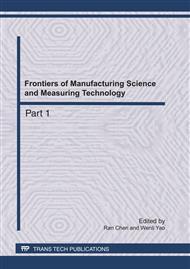p.738
p.743
p.749
p.754
p.759
p.764
p.769
p.774
p.779
Forward Displacement Analysis of the 6-SPS Stewart Mechanism Based on Quaternion and Hyper-Chaotic Damp Least Square Method
Abstract:
The forward displacement analysis of parallel mechanism can be transformed into solving complicated nonlinear equations and it is a very difficult process. Taking chaotic sequences as the initial values of damp least square method, all the solutions of equations can be found and the solving efficiency is related to modeling methods. Making use of existing chaos system and discovering new chaos system to generate chaotic sequences with good properties is the key to the chaos sequences-based damp least square method. Based on the connection topology of chaotic neural network composed of the four chaotic neurons, hyper-chaos exists in the chaotic neural network system. Combining hyper-chaos with damp least square method, a new method to find all solutions of nonlinear questions was proposed, in which initial points are generated by utilizing hyper-chaotic neural network. For the first time, based on quaternion, the model of the forward displacements of 6-SPS parallel mechanism is built up. The result is verified by a numerical example.
Info:
Periodical:
Pages:
759-763
Citation:
Online since:
May 2011
Authors:
Price:
Сopyright:
© 2011 Trans Tech Publications Ltd. All Rights Reserved
Share:
Citation:


